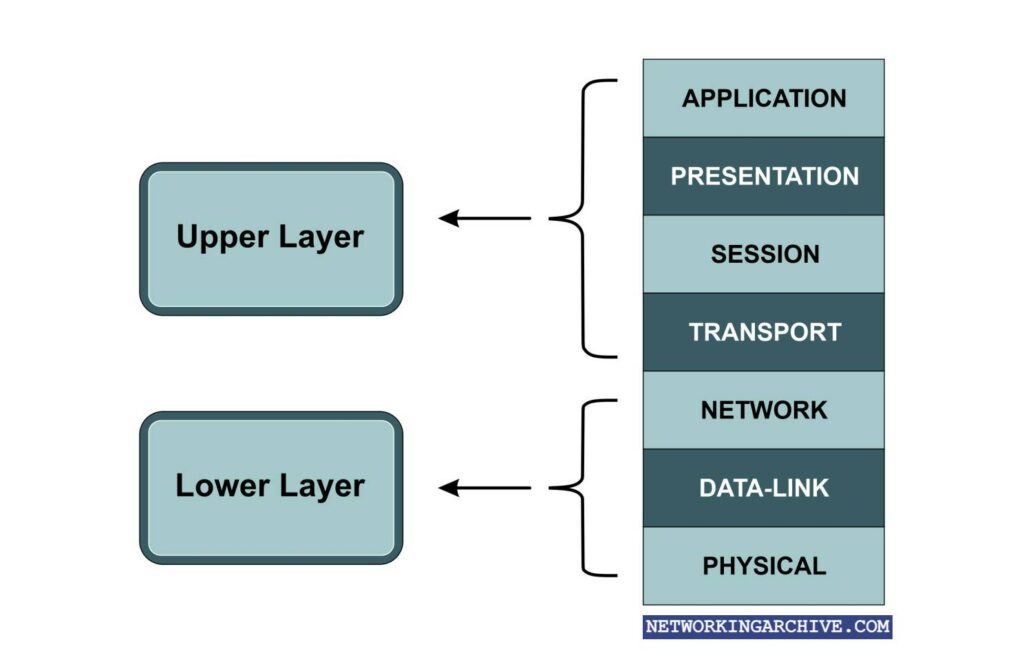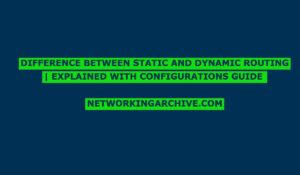OSI Model: 7 Layers Explained in Computer Network

The International Organization for Standardization (ISO) developed the OSI reference model in 1984. It provides the standard of how traffic runs across the network.
There are seven layers under the OSI Reference model.
The top upper layers are considered as the upper layer and the bottom four layers are considered as bottom layers
What is Application Layer in OSI Model?
The application layer provides the interface between the user application and the network. User Application does not reside itself as the application layer but the protocol does.
Example:-
Web browser, email, and Skype are the network applications and the protocols that run under the application are:-
FTP – File transfer protocol as FTP user
HTTP – Hypertext transfer protocol as browser
POP3 & SMTP – as email user
What is Presentation Layer in OSI Model?
The presentation layer controls the formatting and syntax of the application layer. In other words, it converts the information/data from human-readable to machine language like in binary format.
Formatting of data types such as
Presentation layers also perform encryption and decompression of data.
What is Session Layer in OSI Model?
The session layer is responsible for establishing, maintaining, and terminating the session between two devices. If the session terminates session layer recovers the session. It works based on requests and responses between applications. Session layer service commonly uses remote procedure calls (RPCs).
Example:
- PPTP – Point-to-point tunneling protocol
- PAP – Password authentication protocol
It tries to recover the lost session terminate the connection which is not been used for a long period and re-open the connection
Services:-
- Authentication
- Authorization
- Session Restoration
Session fall under three method:
- Full-Duplex – Two-way communication simultaneously
- Half-Duplex – Two-way communication but not simultaneously
- Simplex – One-way communication
What is Transport Layer in OSI Model?
The transport layer does not transfer the data but despite, reliable transfer of data, process-to-process delivery, an end-to-end connection between devices, congestion control, data integrity, error correction, multiplexing, and demultiplexing, flow control
The transport layer has provided two major services
- Connection Oriented (TCP) – source and destination agreed upon specific parameters before sending data.
- Connectionless (UDP) – no specific parameters are needed for data sent.
Connection-oriented protocol provides several important services
- Segmentation and Sequencing – Data is segmented into smaller chunks and assigned a sequence number to reassemble with the arrival side.
- Connection Established – the connection between two devices is established, maintained, and terminated.
- Acknowledgment – to guarantee the transfer of data with the use of acknowledgment.
- Flow Control – It controls the data to prevent congestion in the medium.
Real Life Example:-
- WhatsApp, Instagram, and Email are under the TCP protocol
- Online Video games and media streaming are under the UDP protocol
What is Network Layer in OSI Model?
The network layer is the 5th layer from the top and the 3rd layer from the bottom. It is the most important layer in the OSI model. It has the responsibility for the quality of data and passes and transmits the data. Routing occurs on this layer means choosing the best path from source to destination. In which data is transferred in the form of packets.
Few are the most important roles under the network layer:-
- Assigning Logical Address – The network layer assigns the logical address (IP Address) to the network device to uniquely identify the device. It is useful for the sender and receiver to confirm that the packet has been delivered to the destination. The IP address has two parts, 1st one is the host address and 2nd one is the network address.
- Routing – Routing is the process of identifying the best path of packets, in which multiple routing algorithms are used to determine the best path like link state routing and distance vector routing.
- Host-to-host delivery – The network layer has the responsibility to take care of the packet until it reaches its destination after deciding the best path. Sometimes data deliver more than one router.
- Logical Subnetting – The network Layer also allows to division of the big network into smaller chunks. In which IP address to be used more effectively and less IP address wasted. Due to the small network, it would be easier to find the error.
- Fragmentation and Reassembly – Each node/device has the maximum capacity to carry the data which is called Maximum Transmission Unit (MTU). When it increases the maximum limit it fragments the data into smaller chunks.
- Error Handling – It can be handled the error using different handling techniques like cyclic redundancy check and forward error correction.
- Quality of Service (QOS) – It ensures the quality based on priority to send the data first. It controls the delay.
- Network Address Translation (NAT) – It converts the public address into a private address for the communication between sender and receiver.
- Congestion Control – Congestion control by using the Leaky Bucket Algorithm to leak the data at a constant rate another is the Token Bucket algorithm where tokens are added one by one and sent based on sequencing the token.
- Encapsulation & Decapsulation – Data come from the transport layer network layer encapsulates the header to the packet as source address and destination.
Protocols used under the Network Layer:-
- IP
- IPsec
- ICMP
- IGMP
- GRE
What is Data Link Layer OSI Model?
The data link layer is the 2nd layer of the OSI model. The network layer deals between different networks but the data link layer deals within the network. In which data is transferred in the form of frames. The data link layer is further divided into two sublayers one is Logical Link control (LLC) which provides error messages and acknowledgment and the other one is Media Access Control (MAC) which is responsible for frames. The data link layer works under the switch device.
Multiple Protocols are as follows:
What is Physical Layer in OSI Model?
The physical layer is the bottom layer commonly called 1st layer of the OSI reference model. It deals with the physical and electrical medium. Further, It consists of multiple components like Cables, connectors, and power plugs. It defines how data 0’s and 1’s encoded into signals and decoded on the other end
Physical topology refers to network topology as follows:
Mess Topology
Star Topology
Bus Topology
Ring Topology
Protocols which fall under the physical layer:
- Ethernet with 1000BASE-T
- Ethernet with 1000BASE-SX
- Ethernet at 100BaseT




Pingback: What is Ethernet Technology? Cabling Types and Categories with Examples